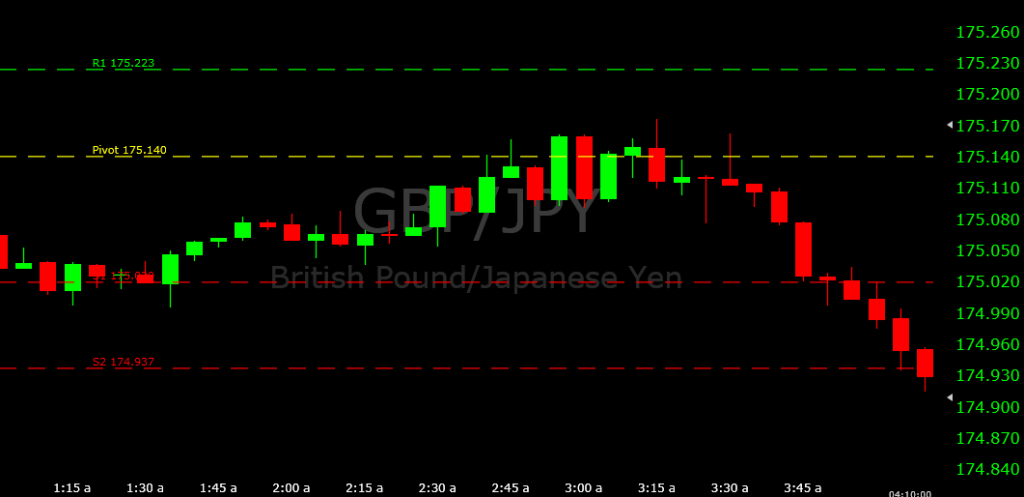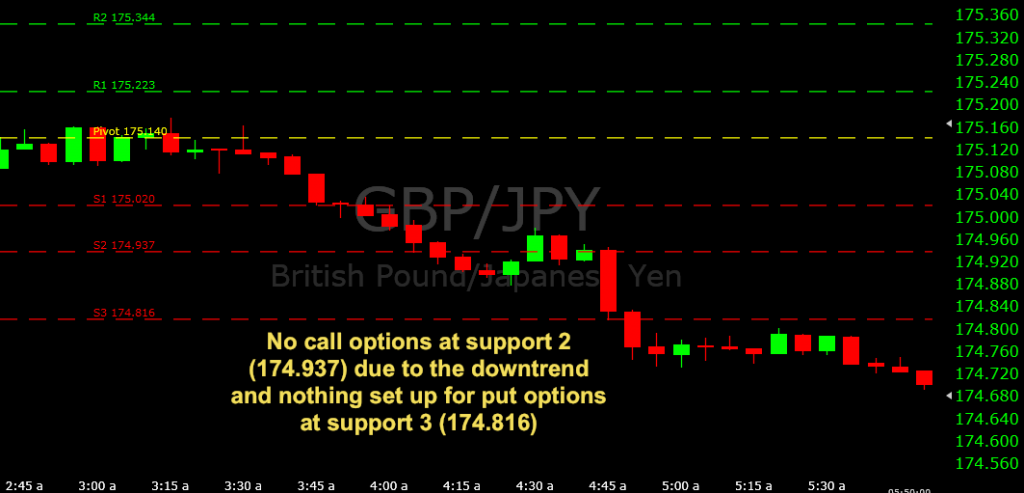GBP/JPY Trading for July 7, 2014
I’m still doing early morning trading and probably will for the remainder of the summer. Today I traded the GBP/JPY, which is usually my back-up option to the EUR/USD. But I had the chart of this pair open and saw price lingering around an area where a set-up could possibly take place, so I rolled with it instead. I basically never trade more than one pair at a time anymore. To me, it’s kind of like sensory overload at times, especially when the market is moving at a decent clip. You never want to overwhelm yourself with too much information. So what I like to do is follow one asset only and set an alert that can be audible when approaching a certain level in the market. It’s makes it simple, not too stressful, and not overly time-consuming.
The nice thing about today’s market was that the pivot points were spaced relatively narrowly apart. Given that pivot points are formulaically based off the action from the previous day, whenever there is a light trading day the next day’s pivots will be spaced closely together. The previous Friday was U.S. Independence Day, a holiday notorious for light trading volume, so it’s understandable. In fact, it wasn’t even 5AM EST yet before the pair began trading outside of its pivot point range (below support 3) and stayed that way.
On the 2:40 candle, the market came up to the pivot level of 175.140 and rejected it immediately. This, of course, is a price action cue telling me that the pivot level is likely to hold on a subsequent re-touch should it occur. It often does happen, given that buy and sell orders in the market tend to be more concentrated on pivot points, major Fibonacci retracement levels, and support and resistance created from previous price history.
When the re-touch came on the 2:45 candle, I got into a put option, expecting that the pivot would hold based on the evidence available to me. As you can observe from the chart, I had the basic idea – the GBP/JPY would hold at its pivot level before dropping off – but the trade didn’t work out. The trade expired at 3AM EST, which coincided with the close depicted by the green candle that made a surge above 175.140.
Given that price hung above this area – i.e., the pivot level itself wasn’t respected as a resistance level – I disqualified further trade opportunities from this area.
Once the market began moving down to support 1 (175.020), I began targeting this area for possible call option set-ups. This level also had acted as support via previous price history from the congestion seen in a half-hour stretch during the 1AM hour. After price touched and rejected 175.020 on the 3:45 candle, I entered into a call option on the 3:50 candle. Essentially I was banking on the next candle being green. Nevertheless, the downtrend resumed and fell through 175.020 on the next candle and ventured down to support 2.
In retrospect, it probably wasn’t a great set-up. Better than 50-50 odds, but not a spectacular one. The 3:45 candle represented a six-pip down move, which suggests bearish action. Based on the support from previous price history, the support 1 pivot point, and the mildly congestive price action during those 1-2 minutes, I felt it was a set-up worth taking. But in this case it simply didn’t work out.
I also did not consider call options at support 2. By this point, the morning downtrend was in full force and the previous nine candles were all red/bearish. So it’s best not to disregard the trend in this case, especially considering how important trend consideration can be when making trading decisions. You may have heard the “trying to catch a falling knife” analogy. It applies here so it was best to sit on my hands in this case.
Following that, it fell below support 3 before 5AM and I had considered put options at support 3. Taking trades off retracements back to support and resistance in the direction of the prevailing trend are my favorite set-ups considering that they have a strong probability of working out. Nonetheless, this didn’t happen so I decided to call it a day. 0/2 in-the-money, but I’m still getting close to 70% ITM since I returned back to trading this summer, so it’s nothing to worry about. Losing days are okay if you followed your strategy well and take what’s available to you. The absolute worst is trying to chase back lost profits through taking low-probability trades, as that will only lead to disaster eventually.



